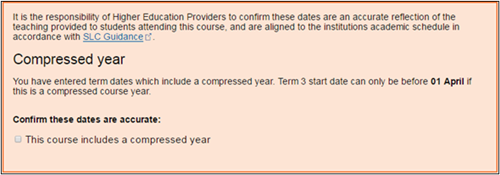Version 1.0 - Last Updated: 08 Jul 2025
Creating a full-time undergraduate course
Shortened and compressed academic year
Where you have a compressed or shortened academic year, students will only be entitled to tuition and living cost support for the next year after a full 12-month period has passed.
A compressed academic year is not the same as an accelerated, compressed or fast-track course. These are defined separately in the Education (Student Support) Regulations.
If you're charging £6,000 for the first year of a full-time course starting in January, you can charge students a full £6,000. This applies whether they're taking this first year over the full academic year (January to December) or in a compressed or shortened mode (for example, January to August). However, you cannot receive a further tuition fee loan for the second year of that course until 1 January the following year.
Students starting full-time or part-time courses where the first year is compressed or shortened can apply for the same up front tuition fee loans as students completing a full academic year. However, they will not be able to access a second year of tuition fee or living costs support until after the end of the full academic year period. This is as defined by regulations.
For example, unless a student is transferring to a new course or has withdrawn from one course to begin another, their academic year start will remain the same throughout their studies.
If you enter term dates for a compressed or shortened academic year, you'll need to confirm this before you can save the course details. CMS will show a confirmation check box that says, 'This course includes a compressed year'.

Entering term dates – undergraduate courses only
English, Scottish and Northern Irish-domiciled students
You should ensure that term dates in CMS reflect the term date advice in this guide. Do not enter term dates that overlap in the same academic year.
Example 1
A student begins a 2.5-year degree programme with a shortened first academic year.
The student’s study pattern is:
Year 1 – January to July
Year 2 – September to July
Year 3 – September to July
CMS must show their study pattern as:
Year 1 – January to December
Year 2 – January to December
Year 3 – January to July
Example 2
A student begins a shortened foundation year before progressing onto the chosen degree pathway.
The student’s study pattern is:
Year 1 – September to December
Year 2 – January to December
Year 3 – January to December
Year 4 – January to December
CMS must show their study pattern as:
Year 1 – September to July
Year 2 – September to July
Year 3 – September to July
Year 4 – September to December
If the final academic year is less than 15 weeks, you cannot receive more than 50% of the maximum fee cap in tuition fee loan. This would be:
- £4,625 for AY 2024/25 and prior
- £4,765 for AY 2025/26 onwards
This fee reflects the shortened academic year.
For full-time courses, you should space the term dates throughout the academic year. This guarantees students are paid at regular and timely intervals, while still respecting the liability period restrictions. It also ensures that the term lengths reflect the teaching provided to students, though we appreciate that this may not align to your true academic schedule.
Welsh-domiciled students
If a Welsh-domiciled student starts a compressed or shortened academic year, the Welsh Government lets them access the next year’s tuition and maintenance support from the point the next year of study begins.
Example
- you confirm the student’s attendance
- you're paid £2,000 fee loan or grant in February
- you confirm the student’s attendance
- you're paid £2,000 fee loan or grant in May
- you confirm the student’s attendance
- you're paid £4,000 fee loan or grant in October